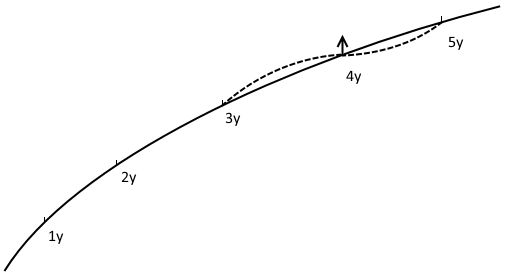The value of a $T$ year payer swap on a coupon payment date at time $t$, or a new swap that is about to be traded today time $t$, is given by
$$V(t) = (S(t,T)-C) \sum_{i=1}^N Z(t_i) \Delta_i$$
where $C$ is the swap coupon, $S(t,T)$ is the current market swap rate to the swap maturity time $T$, $Z(t_i)$ is a LIBOR discount factor to time $t_i$ and $\Delta_i$ is the year fraction over $[t_{i-1},t_i]$. We assume annual coupons so set $\Delta_i=1$ for simplicity so that
$$V(t) = (S(t,T)-C) \sum_{i=1}^N Z(t_i)$$
Bumping the swap curve can change the $T$-maturity market swap rate $S(t,T)$ and the discount factors $Z(t_i)$. Suppose we bump the $S(t,T^*)$ rate where $T^{*}$ is one of the input swap rates used to construct the curve. This is done in a way that keeps ALL other input swap rates CONSTANT. To first order we have
$${\partial V(t)}/{\partial S(t,T^{*})} = \frac{\partial S(t,T)}{\partial S(t,T^*)} \sum_{i=1}^N Z(t_i) + (S(t,T)-C) \times \sum_{i=1}^N \frac{\partial Z(t_i)}{ \partial S(t,T^{*})}$$
where the DV01 equals ${\partial V(t)}/{\partial S(t,T^{*})} \times 1$ basis point. The second term is multiplied by $(S(t,T)-C)$ and so if the market swap rate is close to the swap coupon, i.e. $S(t,T) \simeq C$, this term will be small. For a new swap the second term is exactly zero as $C=S(t,T)$.
Now consider an example.
We build our curve from 1Y, 2Y, 3Y, 4Y, 5Y swap rates and we are valuing a $T=5$ year swap. The value of $T^{*}$ can be $1,2,3,4$ or $5$. Consider then two scenarios:
I) $T^{*}=T$.
The term of the bumped swap rate and swap are same. Suppose $T=5$ and $T^{*}=5$ then
$\partial S(t,T)/\partial S(t,T^*)=1$. Also, bumping $S(t,T^{*}=5)$ will lower discount factors between 4Y and 5Y. This means that
$$\partial V(t) / \partial S(t,T^{*}) = \sum_{i=1}^N Z(t_i) + (S(t,T)-C) \times \sum_{i=1}^N \frac{\partial Z(t_i)}{ \partial S(t,T^{*})}$$
The second term will usually be small, especially for a new swap, so we can write $\partial V(t) / \partial S \simeq \sum_{i=1}^N Z(t_i)$. This term is usually known as the swap PV01.
II) $T^{*} <> T$. The term of the bumped swap rate and swap are different. Consider $T=5$ and $T^{*}=4$ then
$\partial S(t,T)/\partial S(t,T^*)=0$. Also, bumping $S(t,T^{*}=4)$ will only lower discount factors between 3Y and 4Y but those between 4Y and 5Y will need to rise to compensate so that the 5Y rate is still matched. The effect at 5 years on the sum of the discount factors will be almost cancelling. This means that
$$\partial V(t) / \partial S(t,T^{*}) = 0 + (S(t,T)-C) \times \sum_{i=1}^N \frac{\partial Z(t_i)}{ \partial S(t,T^{*})}$$.
The second term will be very small due to partially offsetting changes in the discount factors, and especially if the swap rate is close to its initial coupon.
So in summary,
For an existing swap
- If $T^{*} = T$, the DV01 is approximately equal to the swap PV01
- If $T^{*} <> T$, the swap DV01 will be close to zero.
For a new swap
- If $T^{*}=T$ the DV01 exactly equals the swap PV01
- If $T^{*} <> T$ the swap DV01 is exactly zero.

